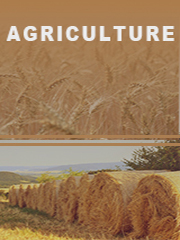TOP CATEGORY: Chemicals & Materials | Life Sciences | Banking & Finance | ICT Media

Microbial agricultural inoculants, commonly referred to as soil inoculants, are agricultural products that leverage beneficial microorganisms, such as bacteria, fungi, and other microbes, to enhance plant growth and soil health. These inoculants often involve microorganisms that engage in symbiotic relationships with plants, benefiting both the microbes and the plants involved through mutualism.
The microbes within these inoculants work by improving nutrient absorption, enhancing soil structure, promoting plant disease resistance, and increasing crop yield. The most common forms of microbial inoculants are applied either to soil or seeds, with each method providing distinct benefits. For example, soil inoculation is aimed at boosting microbial populations in the soil, while seed inoculation directly applies beneficial microbes to the seeds before planting, allowing for early-stage growth benefits.
These agricultural inoculants are becoming increasingly popular as sustainable alternatives to traditional chemical fertilizers and pesticides, offering a more eco-friendly solution to crop protection and enhancement.
Market Size
The global microbial agricultural inoculants market has seen significant growth and is expected to continue its upward trajectory. In 2024, the market was valued at USD 4.23 billion, with expectations to grow at a compound annual growth rate (CAGR) of 12.00%, reaching an estimated USD 10.47 billion by 2032.
This growth is being driven by the rising demand for sustainable agricultural practices and a shift away from harmful chemical inputs.
In North America alone, the microbial agricultural inoculants market was valued at USD 1.34 billion in 2024, with a projected CAGR of 10.29% from 2025 through 2032.
As global awareness of environmental sustainability increases, more farmers and agricultural businesses are adopting microbial inoculants to reduce their reliance on synthetic chemicals and improve soil health.

Market Dynamics
Drivers
The growing demand for sustainable farming practices and environmentally friendly agricultural products is the primary driver of the microbial agricultural inoculants market. The following factors are contributing to the market’s expansion:
Sustainability Focus: The increasing shift towards organic farming and sustainable agricultural practices is driving the adoption of microbial inoculants.
Reduction in Chemical Dependency: Governments and consumers are increasingly demanding alternatives to synthetic fertilizers and pesticides, making microbial inoculants an attractive option.
Improved Crop Yield: Microbial inoculants contribute to improved soil fertility and healthier crops, resulting in higher yields, which is crucial to meet the growing global food demand.
Soil Health: Inoculants enhance soil structure and nutrient cycling, improving long-term soil health and agricultural productivity.
Restraints
Despite its growth potential, the microbial agricultural inoculants market faces several challenges:
Awareness and Knowledge Gap: Farmers in some regions still lack awareness about the benefits and usage of microbial inoculants.
Cost Considerations: The initial investment in microbial inoculants and their application can be seen as an added expense for farmers, especially in regions where traditional farming practices dominate.
Regulatory Challenges: There is a lack of standardized regulations across regions, which can slow down the market’s development and adoption.
Opportunities
The microbial agricultural inoculants market presents several growth opportunities:
Emerging Markets: The increasing adoption of sustainable practices in developing countries offers untapped potential for microbial inoculants.
Technological Advancements: Ongoing research into microbial technology can lead to more effective and cost-efficient products, further driving market growth.
Diversification in Applications: The expanding use of microbial inoculants in various agricultural sectors beyond traditional crop farming, such as horticulture and turf management, presents new revenue streams.
Challenges
The market faces challenges such as:
Climate Change: Climate variability affects soil conditions, which can impact the efficacy of microbial inoculants.
Inconsistent Performance: The performance of microbial inoculants can vary based on environmental factors, making consistency a challenge for widespread adoption.
Regional Analysis
North America
North America holds a significant share of the microbial agricultural inoculants market. The United States and Canada are leading the way in adopting sustainable agricultural practices, including the use of microbial inoculants. In the coming years, demand is expected to rise, especially with the U.S. government’s support for environmentally friendly farming techniques and the growing interest in organic farming.
Europe
Europe is another key market, with countries like Germany, the United Kingdom, and France investing in sustainable farming technologies. The European Union’s strict regulations regarding pesticide use further propel the adoption of microbial agricultural inoculants.
Asia-Pacific
The Asia-Pacific region, particularly countries like China and India, is expected to see significant growth in the microbial inoculants market. These countries face challenges such as soil degradation and the need for improved crop productivity, making microbial inoculants an appealing solution.
Latin America
Brazil and Argentina dominate the microbial agricultural inoculants market in Latin America. These countries are major agricultural producers, and the growing interest in sustainable farming practices is fueling market demand.
Middle East and Africa
In the Middle East and Africa, there is a rising trend toward sustainable agricultural practices, driven by the need to enhance crop productivity in water-scarce regions. This presents a significant growth opportunity for microbial inoculants.
Competitor Analysis
Key players in the microbial agricultural inoculants market include:
BASF: A leading chemical company known for its development of agricultural products, including microbial inoculants that improve soil health.
Bayer: Another key player offering a range of agricultural products, including microbial solutions for sustainable farming.
Corteva: A major agricultural company focusing on providing innovative microbial inoculants to enhance crop yields.
Novozymes: Known for its expertise in enzymes and microbial products, Novozymes is a key player in the microbial agricultural inoculants market.
ABM: A company specializing in biological solutions for agricultural applications, including microbial inoculants.
These companies are increasingly focusing on R&D to improve the efficacy and application methods of microbial inoculants, giving them a competitive edge in the market.
Global Microbial Agricultural Inoculants: Market Segmentation Analysis
This report provides a deep insight into the global microbial agricultural inoculants market, covering all its essential aspects. This ranges from a macro overview of the market to micro details such as market size, competitive landscape, development trends, niche market, key market drivers and challenges, SWOT analysis, value chain analysis, and more.
The analysis helps the reader understand the competition within the industry and strategies for navigating the competitive environment to enhance potential profits. Furthermore, it provides a simple framework for evaluating and assessing the position of the business organization. This report also focuses on the competitive landscape, providing in-depth insights into market share, product situation, operational situation, etc., of the leading players, enabling industry professionals to identify primary competitors and comprehend market dynamics.
In a word, this report is a must-read for industry players, investors, researchers, consultants, business strategists, and all those interested in the microbial agricultural inoculants market.
Market Segmentation (by Application)
Oilseeds and Pulses
Fruits and Vegetables
Cereals and Grains
Others
Market Segmentation (by Type)
Soil Inoculation
Seed Inoculation
Key Company
BASF
Bayer
Corteva
Novozymes
ABM
BIO-CAT
TerraMax
XiteBio Technologies
Geographic Segmentation
North America (USA, Canada, Mexico)
Europe (Germany, UK, France, Russia, Italy, Rest of Europe)
Asia-Pacific (China, Japan, South Korea, India, Southeast Asia, Rest of Asia-Pacific)
South America (Brazil, Argentina, Colombia, Rest of South America)
The Middle East and Africa (Saudi Arabia, UAE, Egypt, Nigeria, South Africa, Rest of MEA)
FAQ
What is the current market size of microbial agricultural inoculants?
Which are the key companies operating in the microbial agricultural inoculants market?
What are the key growth drivers in the microbial agricultural inoculants market?
Which regions dominate the microbial agricultural inoculants market?
What are the emerging trends in the microbial agricultural inoculants market?
Key Benefits of This Market Research:
Key Reasons to Buy this Report:
Frequently Asked Questions ?
